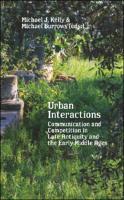Urban Interactions
Communication and Competition in Late Antiquity and the Early Middle Ages
| dc.contributor.editor | Kelly, Michael J. | |
| dc.contributor.editor | Burrows, Michael | |
| dc.contributor.other | Bailey, Lisa Kaaren | |
| dc.contributor.other | Christys, Ann | |
| dc.contributor.other | Kyrtatas, Dimitris J. | |
| dc.contributor.other | Martínez Jiménez, Javier | |
| dc.contributor.other | Mateos Cruz, Pedro | |
| dc.contributor.other | Mulryan, Michael | |
| dc.contributor.other | Sánchez Ramos, Isabel | |
| dc.contributor.other | Tizzoni, Mark Lewi | |
| dc.contributor.other | Underwood, Douglas | |
| dc.contributor.other | Wood, Ian | |
| dc.date.accessioned | 2020-10-14T09:15:08Z | |
| dc.date.available | 2020-10-14T09:15:08Z | |
| dc.date.issued | 2020 | |
| dc.identifier | OCN: 1328265832 | |
| dc.identifier.uri | https://library.oapen.org/handle/20.500.12657/42581 | |
| dc.description.abstract | "This volume is dedicated to eliciting the interactions between localities across late antique and early medieval Europe and the wider Mediterranean. Significant research has been done in recent years to explore how late “Roman” and post-“Roman” cities, towns and other localities communicated vis-à-vis larger structural phenomena, such as provinces, empires, kingdoms, institutions and so on. This research has contributed considerably to our understanding of the place of the city in its context, but tends to portray the city as a necessarily subordinate conduit within larger structures, rather than an entity in itself, or as a hermeneutical object of enquiry. Consequently, not enough research has been committed to examining how local people and communities thought about, engaged with, and struggled against nearby or distant urban neighbors. Urban Interactions addresses this lacuna in urban history by presenting articles that apply a diverse spectrum of approaches, from archaeological investigation to critical analyses of historiographical and historical biases and developmental consideration of antagonisms between ecclesiastical centers. Through these avenues of investigation, this volume elucidates the relationship between the urban centers and their immediate hinterlands and neighboring cities with which they might vie or collaborate. This entanglement and competition, whether subterraneous or explicit across overarching political, religious or other macro categories, is evaluated through a broad geographical range of late “Roman” provinces and post-“Roman” states to maintain an expansive perspective of developmental trends within and about the city." | en_US |
| dc.language | English | en_US |
| dc.subject.classification | thema EDItEUR::N History and Archaeology::NK Archaeology::NKD Archaeology by period / region | en_US |
| dc.subject.classification | thema EDItEUR::1 Place qualifiers::1D Europe | en_US |
| dc.subject.classification | thema EDItEUR::3 Time period qualifiers::3K CE period up to c 1500::3KL c 1000 CE to c 1500 | en_US |
| dc.subject.classification | thema EDItEUR::K Economics, Finance, Business and Management::KC Economics::KCV Economics of specific sectors::KCVS Regional / urban economics | en_US |
| dc.subject.other | early middle ages | en_US |
| dc.subject.other | late antiquity | en_US |
| dc.subject.other | mediterranean | en_US |
| dc.subject.other | visigoths | en_US |
| dc.subject.other | urbanism | en_US |
| dc.subject.other | vandals | en_US |
| dc.subject.other | commerce | en_US |
| dc.subject.other | umayyads | en_US |
| dc.title | Urban Interactions | |
| dc.title.alternative | Communication and Competition in Late Antiquity and the Early Middle Ages | en_US |
| dc.type | book | |
| oapen.identifier.doi | 10.21983/P3.0300.1.00 | |
| oapen.relation.isPublishedBy | 979dc044-00ee-4ea2-affc-b08c5bd42d13 | en_US |
| oapen.relation.isbn | 9781953035059 | |
| oapen.relation.isbn | 9781953035066 | |
| oapen.collection | ScholarLed | en_US |
| oapen.pages | 442 | en_US |
| oapen.place.publication | Brooklyn, NY | en_US |

